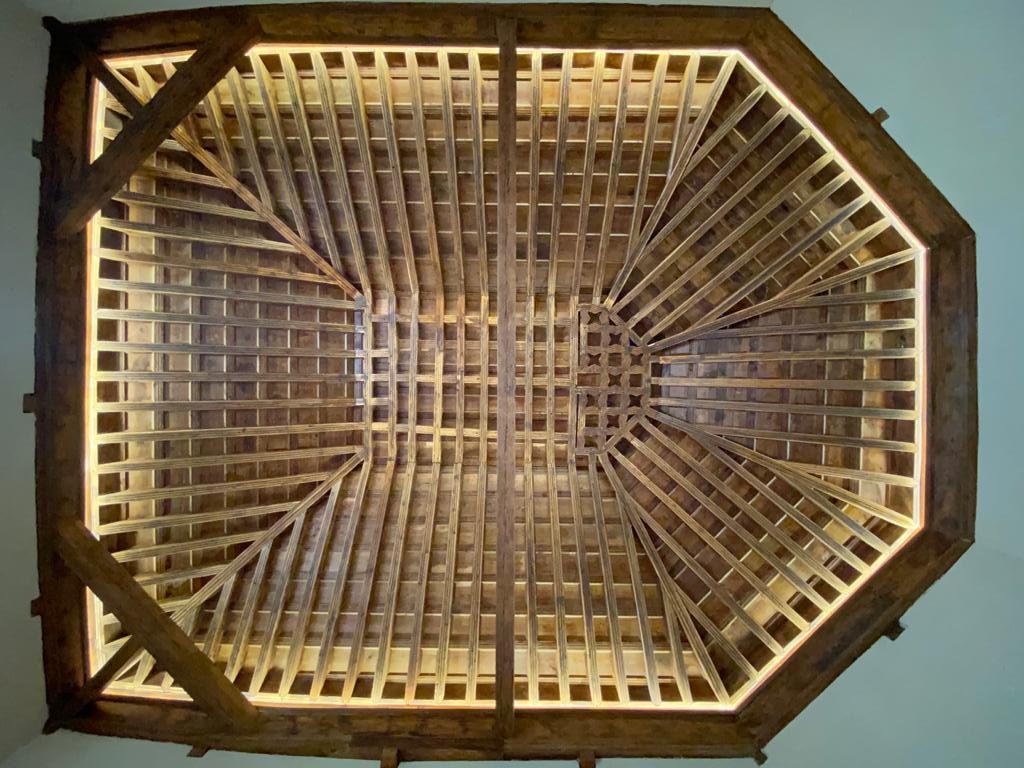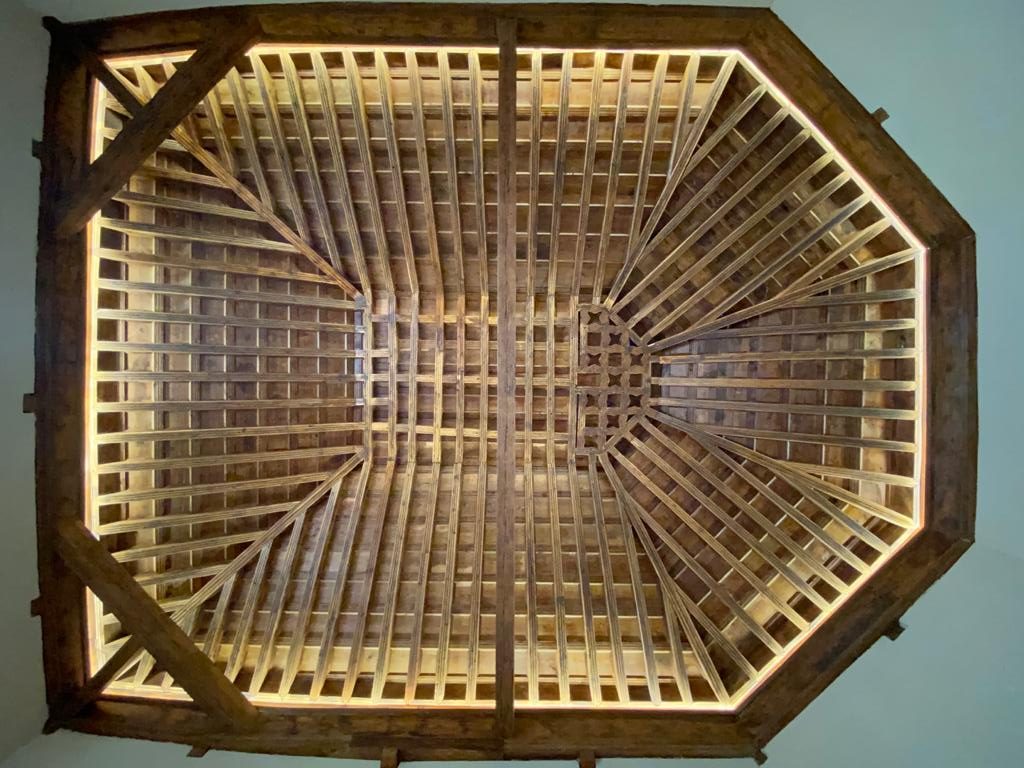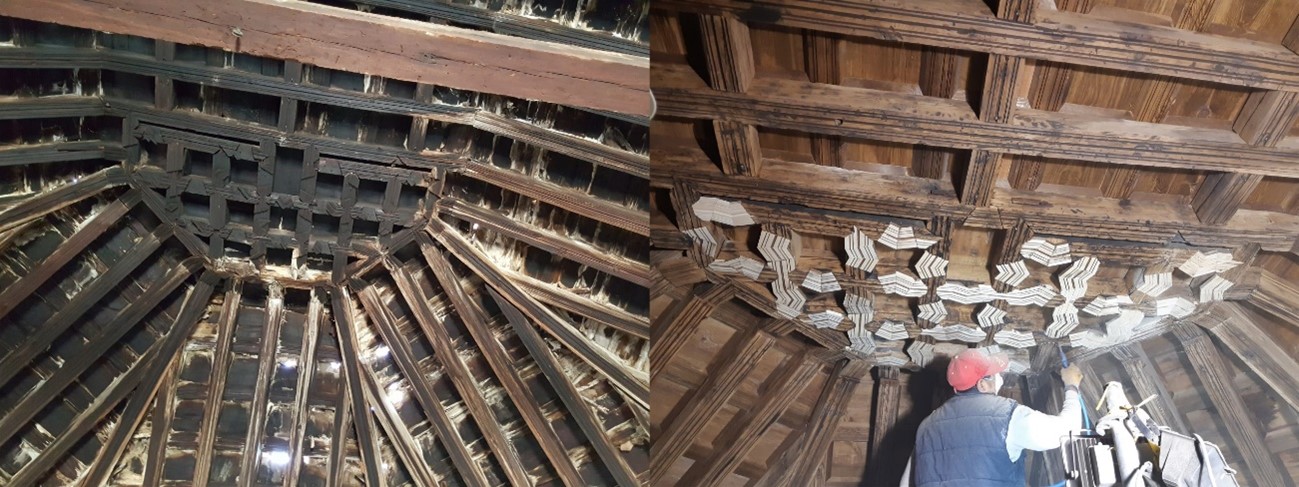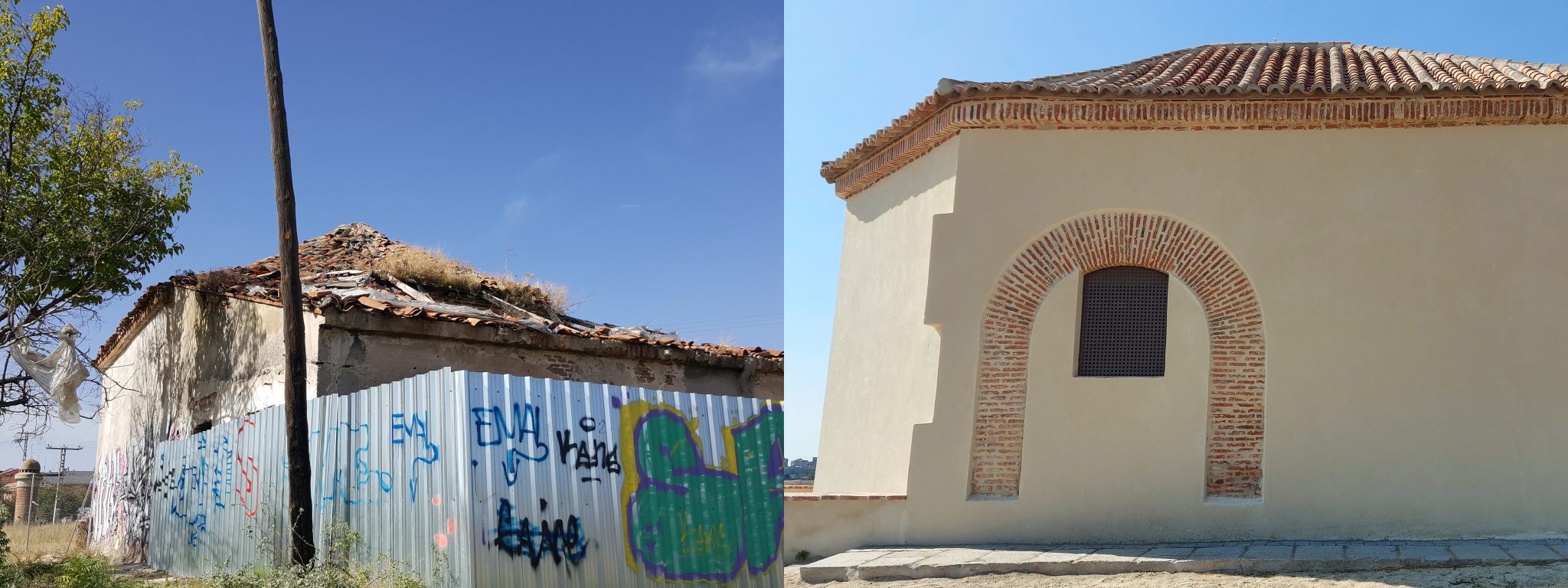7 July 2022
for Madrid Nuevo Norte


Restoration work ‘in situ’ of the coffered ceiling of the San Roque chapel in Fuencarral, carried out following a strict criterion of maximum conservation of the original elements. Photo: Madeplagas.
Current district of Fuencarral, which was a village, has recuperated one of its historic landmarks thanks to the complete restoration of the 16th-century chapel dedicated to San Roque. Its discreet exterior conceals one of the only three surviving coffered ceilings of Mudejar lacquer work in the city of Madrid. As part of the Madrid Nuevo Norte urban regeneration project, the chapel will remain in its original location and will become a fundamental part of the green artery that will join the public spaces in the northern part of the urban development project area with the Hills of El Pardo.
The most outstanding element of this monument is the coffered ceiling, which covers the entire interior space. Also known as “armaduras de lazo” (looped armatures), coffered ceilings are one of the most representative features of the interiors in Mudéjar architecture, a genuinely Spanish historical style that emerged from the application of constructions techniques, materials and forms from Islamic architecture into Christian buildings. Its impressive wooden ceilings, worked in the form of an inverted trough, reproduced geometric shapes that were worked by highly specialised and valued masters.
As the architect who directed the restoration work on the building, Pedro Ponce de León explains that “its design and construction was based on a profound knowledge of the geometry, assembly techniques and structural behaviour of wood”. Compared with the only two other surviving wooden coffered ceilings of Mudejar origin in Madrid, those of the church of Santa María la Blanca in Canillejas and the centrally located San Nicolás de los Servitas, both dating from the 15th century, the singularity of San Roque lies in the fact that, being a more modest-sized chapel, the coffered ceiling covers the entire roof of the church, explains the architect.
“The main challenge of restoring the coffered ceiling,” says the architect, “was to recover its stability and solidity with minimal intervention, and also to do it ‘in situ’, preserving its authenticity and thus avoiding its complete dismantling and transfer to a workshop”.

View of the Mudejar coffered ceiling of the San Roque chapel, after completing its restoration. Photo: Madeplagas.
The chapel suffered serious deterioration from rainwater damp, which caused the wood to rot and attracted wood-eating insects. In addition, the interior was blackened by the lighting of bonfires during its years of neglect, and lack of maintenance. The restoration, promoted by Madrid City Council’s Directorate General of Heritage, has been carried out with a view to preserving the original elements wherever possible, according to Roberto de las Heras, technical manager of the company Madeplagas, who participated in the restoration work.
Roberto de las Heras, an expert in restoration of reinforcement carpentry in historic buildings, specified that “approximately 20% of the wooden cladding board and elements of the coffered ceiling made of ribbon board and wooden beams were used, the rest had to be replaced”. The technician explains that “there were elements that were in such a bad state that they had to be replaced, such as the so-called ‘sleeper’ beams”. The continuous and constant rotting, when it reaches very advanced levels, means that the wood loses consistency, most of its fibres become detached, and it is beyond recovery. For the replacements, the same wood as the original structure, Scots pine, was used.

Condition of the central area of the coffered ceiling before and during restoration. The missing geometric figures were recovered using four-pointed stars based on traces and hollows left in the wood. Photos: Madeplagas.
“After levelling, reinforcing, replacing, sanding, etc., a chemical treatment was applied to the wood,” explains De las Heras, to protect and cure the wood, as well as to prevent the presence of wood-eating insects. Subsequently, “a decorative finish was applied, toning both the new and old parts, in order to smooth out the differences”, explained the expert.
In the central part of the coffered ceiling, which is known as the “almizate” and which was the most decorated part of the ceiling, “an area of lacemaking was missing and, based on the traces that were on the knuckles of the almizate, we were able to reconstruct these geometric figures based on four-pointed stars, taking advantage of the elements that remained”, added Heras.
According to the architect in charge of the project, the roof is even older than the rest of the building: “It seems clear that it was not built ‘ex profeso’, but was transported from another place and a from a different building, requiring adjustments and modifications to the crowns and the layout of the perimeter walls of the chapel”. These walls have also been restored, are made of brick, and small stone boxes with unbaked mud or tapial, as Ponce de León explained.
During the restoration work, a surprising discovery was made: as the architect recounts, during the cleaning and opening of the old niches in the apse, “images of saints of great interest appeared, embedded in the two side niches, which had been hastily hidden there, under a masonry partition wall, and which were moved for restoration”. Meanwhile, the local historian of Fuencarral, José Martín de la Fuente, pointed out that of the newly discovered images, “the most valuable is a Saint Anton from the school of Alonso Berruguete”.

Before and after photos showing the transformation of the exterior of the chapel. Photos: Madeplagas.
In the opinion of the architect-restorer, “the chapel was certainly an isolated milestone in the rustic landscape of Fuencarral from the 17th-18th centuries onwards”. And regarding its use, he explained that the complex “has a small room attached to the outside of the apse, of more recent construction, which could have been used as a small lazaretto for the sick or for the chapel’s custodian”. At that time there was a deep-rooted tradition of using the chapel dedicated to San Roque – the patron saint of the sick and a pilgrim to Rome – to receive the sick and travellers. Added to this is the fact that the chapel was located on the natural passage through Fuencarral from Madrid to Santiago de Compostela, so it is possible that it once served as a small hospital for pilgrims.
According to the historian José Martín de la Fuente, the 16th century, when the temple was built, was “a period plagued by droughts, floods and multiple epidemics, mainly plague and catarrh, which, surely, would not differ much from the current Covid-19”. Because of this, explains the historian, the town of Madrid made a perpetual vow to San Roque in 1507, a milestone of which there is documentary evidence.